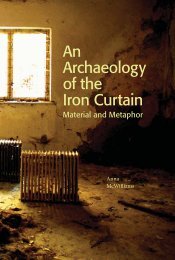Create successful ePaper yourself
Turn your PDF publications into a flip-book with our unique Google optimized e-Paper software.
101<br />
101<br />
A LARGE SILVER REPOUSSÉ BOWL<br />
LUCKNOW, <strong>INDIA</strong>, CIRCA 1900<br />
On large domed circular foot, with straight body and slightly everted rim, the<br />
high repoussé decoration with hunting scenes, including wild boar, elephant<br />
and felines, a wide register of repeating palmettes below<br />
11æin. (30cm.) diam., 10Ωin. (26.6cm.) high<br />
£4,000-6,000 $5,700-8,500<br />
€5,000-7,500<br />
The form of our bowl recalls the ofering vessels found in southeast Asia and<br />
especially in Burma. However, the iconography of the hunt, the dynamism<br />
of the scenes and the traits and attire of the hunters suggest Lucknow as<br />
a place of production (Wilkinson, Wynyard R. T., Indian Silver, 1858-1947,<br />
London 1999, pp. 126-127). The present hunt scene is particularly attractive<br />
and shows great energy. A similar bowl albeit with a blank escutcheon<br />
fanked with unicorns is illustrated in V. Dehejia, Delight in Design, Indian<br />
Silver for the Raj, Ahmedabad, 2008, p. 1777, cat. 79.<br />
~103<br />
AN IVORY AND ANTELOPE HORN POWDER PRIMER<br />
POSSIBLY LAHORE, NORTH <strong>INDIA</strong>, LATE 18TH OR EARLY 19TH<br />
CENTURY<br />
Of typical form, the ribbed horn body with lotus fower bud fnial, the ivory<br />
mouth fashioned as a leaping antelope, its forelegs under its belly, with<br />
spiralling horns and bulging eyes, steel stopper<br />
11Ωin. (29.3cm.) long<br />
£3,000-5,000 $4,300-7,100<br />
€3,800-6,200<br />
A primer of similar construction consisting of a horn with an attached<br />
carved ivory head in the Victoria and Albert Museum is attributed to Lahore,<br />
late 18th or early 19th century (Susan Stronge (ed), The Arts of the Sikh<br />
Kingdoms, London, 1999, no.161, p.141).<br />
102<br />
A LARGE BOMBAY ENAMELLED TIN AND GLAZED POTTERY JAR<br />
BOMBAY SCHOOL <strong>OF</strong> ART, <strong>INDIA</strong>, CIRCA 1870-90<br />
Of bulbous form with tapering neck issuing four elephant heads with curved<br />
trunks rising to wide faring mouth, the dome-shaped lid with a depiction of<br />
Ganesh seated cross-legged, the sides with painted scenes of the Ramayana,<br />
the shoulder with two bands of devanagari, the neck with grotesque makaratype<br />
heads issuing pearls, the underside of the base signed with initials in<br />
devanagari, the underside of the lid marked shri<br />
38ºin. (97.2cm.) high<br />
102<br />
£3,000-5,000 $4,300-7,100<br />
€3,800-6,200<br />
This impressive vase is topped with a fgure of the elephant-headed god<br />
Ganesh and painted with scenes of rural life and epics recalling those found<br />
on Calcutta and Poona silverwares. With its green and brown pigments it<br />
brings to mind the Wonderland Art Pottery vase now kept at the Victoria and<br />
Albert Museum (IM.41-1917). This type of pottery production was made at<br />
the Bombay School of Art and was led by a company trading under the name<br />
of Wonderland Art Pottery under the artistic direction of George Wilkins<br />
Terry. The production fourished from the 1870s to the 1890s.<br />
103




